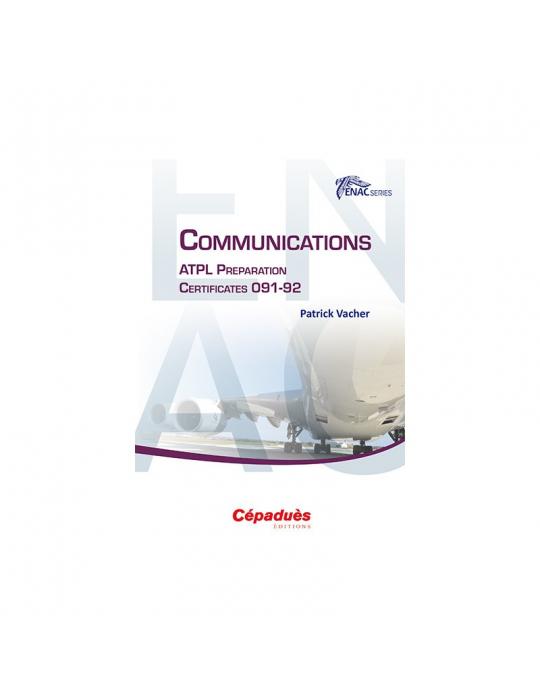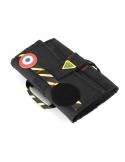Livraison colissimo offerte à partir de 150€ d'achats pour toute expédition en France métropolitaine + Corse.
COMMUNICATIONS ATPL PREPARATION CERTIFICATES 091-92
This book entilted Communications follows the EASA syllabus and learning objectives to train students for ATPL communication 091-092 certificates.
1118
1 Article
Nouveau produit

Paiement sécurisé

Livraison gratuite A partir de 150€

Retour: Délai de 14 jours ouvrés
This book entilted Communications follows the EASA syllabus and learning objectives to train students for ATPL communication 091-092 certificates.
All the texts about VFR and IFR communications coming from different ICAO annex and documentations have been classified to obtain an understandable book.
This book, also includes at the end of each learning objectives, consolidation questions and answers.
Patrick Vacher has been a trainer in navigation and communication for many years at the ENAC.
TABLE OF CONTENTS
0. Preamble: Organisation of telecommunications
0.1. General
0.1.1. Interest of telecommunications for the civil aviation
0.1.2. Organizations using telecommunications
0.1.3. The International Telecommunication Union (ITU)
0.1.4 ICAO
0.1.5 Europe and European Aviation Safety Agency (EASA)
1. Definitions
1.1 Meaning of associated terms
Consolidation questions
1.2 Abbreviation of the Air Traffic Control Unit
Consolidation questions
1.3 Frequently used Q code groups
Consolidation questions
1.4 Categories of messages
Consolidation questions
2. General operating procedures
2.1 Transmission of letters
2.2 Transmission of numbers (including level information)
2.3 Transmission of time
2.4 Transmitting technique
Consolidation questions
2.5 Standard words and phrases (including radiotelephony phraseology)
Consolidation questions
2.6 Radiotelephony call signs for aeronautical stations including abbreviated call signs
2.7 Radiotelephony call signs for aircrafts including abbreviated call signs
2.8 Communication procedures
2.8.1 Establishment and continuation of radiotelephony communications
2.8.2 Transfer of HF communications
2.8.3. SELCAL procedures
2.9 Radio test procedures including the readability scale
2.10 Conditions of readback and acknowledgement of receipt
2.11 Phraseology of radar control
2.11.1 General
2.11.2 Identification
2.11.3 Radar vectoring
2.11.4 Information on traffic
2.11.5 Prevention measures
2.11.6 Secondary Surveillance Radar (SSR)
2.11.7 Radar Assistance to Aircraft with Radio Communications Failure
2.12 Level change and reporting
2.12.1 Level change
2.12.2 Reports
Consolidation questions
3. Terms relating to meteorological information
3.1 Meteorological conditions over the aerodrome
3.2 Meteorological messages
3.2.1 Meteorological forecasting
3.2.2 Meteorological information
Terms relating to meteorological information
4. Actions taken in case of communication failure
4.1 Notification of communications failure
Consolidation questions
5. Distress and urgency radiotelephony communication procedures
5.1 Distress
5.1.1 Definitions
5.1.2 Frequencies
5.1.3 Listening watch of distress frequencies
5.1.4 Signal
5.1.5 Message
5.2 Urgency
5.2.1 Definitions
5.2.2 Frequencies
5.2.3 Signal
5.2.4 Messages
5.3 PAN Medical
5.3.1 Action by an aircraft used for medical transports
5.3.2 Action by the station addressed or by other stations receiving a medical transports message
5.4 Communications related to acts of hijaking
Consolidation questions
6. General principles on propagation of VHF waves and allocation of frequencies – Allocation of frequencies
6.1 Utilization of frequencies below 30 MHz
6.1.1 Frequency bands used by the mobile service
6.1.2 Bands allocated to the radionavigation service
6.2 Utilization of frequencies above 30 MHz
6.2.1 Utilization in the band 117.975 MHz-137 MHz allocated to the aeronautical mobile service
6.2.2 Frequency bands for the aeronautical mobile-satellite service
6.2.3 Frequency bands for the Aeronautical Radio Navigation Service
6.2.4 Distress frequencies
6.2.5 Deployment of frequencies and the avoidance of harmful interference
Consolidation questions
7. Morse code (IFR communications)
8. ACARS system
9 ACAS (Alert and Collision Avoidance System)
Appendix 1 Phraseology - Doc 4444-ATM/501 ICAO
Appendix 2 TIBA and IFBP Procedures
Appendix 3 Communication references
1118
1 Article
Nouveau produit






